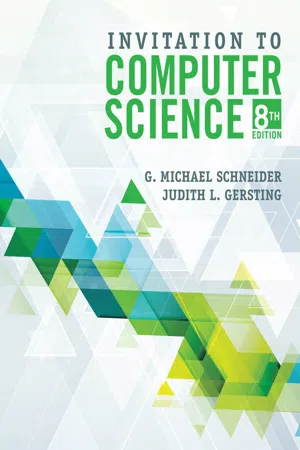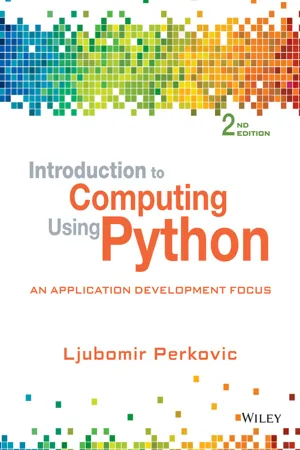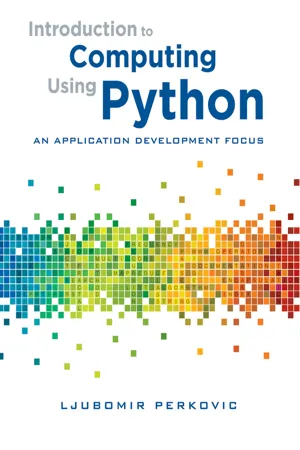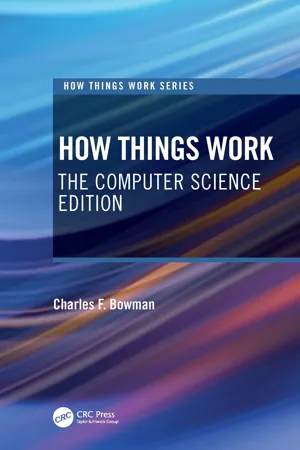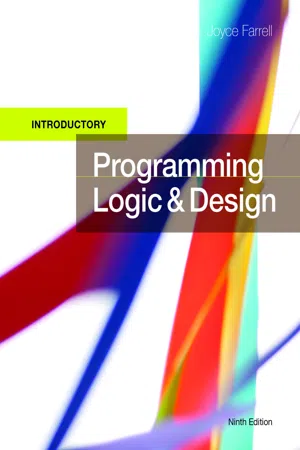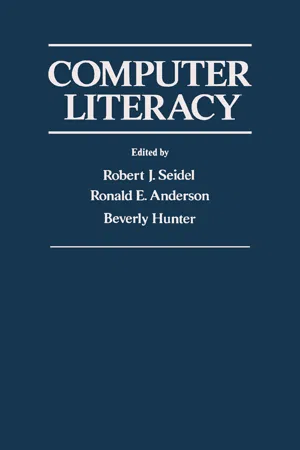Computer Science
Computer Programming
Computer programming involves writing, testing, and maintaining the source code of computer programs. It is the process of designing and building an executable computer program to accomplish a specific computing result. Programming languages such as Python, Java, and C++ are used to communicate instructions to a computer.
Written by Perlego with AI-assistance
Related key terms
1 of 5
12 Key excerpts on "Computer Programming"
- eBook - PDF
- G.Michael Schneider, Judith Gersting(Authors)
- 2018(Publication Date)
- Cengage Learning EMEA(Publisher)
This almost universal 1 Fellows, M. R., and Parberry, I. “Getting Children Excited About Computer Science,” Computing Research News, vol. 5, no. 1 (January 1993). Copyright 2019 Cengage Learning. All Rights Reserved. May not be copied, scanned, or duplicated, in whole or in part. Due to electronic rights, some third party content may be suppressed from the eBook and/or eChapter(s). Editorial review has deemed that any suppressed content does not materially affect the overall learning experience. Cengage Learning reserves the right to remove additional content at any time if subsequent rights restrictions require it. 4 Chapter 1 An Introduction to Computer Science use of programming as the entry to the discipline can create the misunder-standing that computer science is equivalent to Computer Programming. Programming is extremely important to the discipline—researchers use it to study new ideas and build and test new solutions—but, like the computer itself, programming is a tool. When computer scientists design and analyze a new approach to solving a problem or create new ways to represent infor-mation, they often implement their ideas as programs to test them on an actual computer system. This enables researchers to see how well these new ideas work and whether they perform better than previous methods. For example, searching a list is one of the most common applications of computers, and it is frequently applied to huge problems, such as finding one specific account among the approximately 63,000,000 active listings in the Social Security Administration database. A more efficient lookup method could significantly reduce the time that telephone-based customers must wait before receiving answers to questions regarding their accounts. Assume that we have designed what we believe to be a “new and improved” search technique. - No longer available |Learn more
- (Author)
- 2014(Publication Date)
- College Publishing House(Publisher)
A programming language provides a structured mechanism for defining pieces of data, and the operations or transformations that may be carried out automatically on that data. A programmer uses the abstractions present in the language to represent the concepts involved in a computation. These concepts are represented as a collection of the simplest elements available (called primitives). Programming is the process by which programmers combine these primitives to compose new programs, or adapt existing ones to new uses or a changing environment. Programs for a computer might be executed in a batch process without human interaction, or a user might type commands in an interactive session of an interpreter. In this case the commands are simply programs, whose execution is chained together. When a language is used to give commands to a software application (such as a shell) it is called a scripting language. Measuring language usage It is difficult to determine which programming languages are most widely used, and what usage means varies by context. One language may occupy the greater number of programmer hours, a different one have more lines of code, and a third utilize the most CPU time. Some languages are very popular for particular kinds of applications. For example, COBOL is still strong in the corporate data center, often on large mainframes; FORTRAN in engineering applications; C in embedded applications and operating systems; and other languages are regularly used to write many different kinds of applications. - Jocelyn O. Padallan(Author)
- 2020(Publication Date)
- Arcler Press(Publisher)
For instance, Microsoft Word and Adobe Photoshop are the two commonly used programs. Microsoft Word is defined as a word processing program that allows an individual to create, edit, as well as print the documents with the computer. Adobe Photoshop is defined as an image editing program that allows you to work with graphic images, such as photos taken with your digital camera. Fundamentals of Computer Programming 3 Programs are generally referred to as software. Software is very important to a computer. This is because the software controls everything that the computer does. All of the software that is used in order to make computers use is made by the people who are working as software developers or programmers. A software developer or programmer is an individual that is having the training as well as the skills required to design, make, and test all the computer programs. Computer Programming is considered as exciting as well as a rewarding profession. In the present times, an individual will find programmers’ work that is used in many fields such as government, entertainment, business, law enforcement, medicine, agriculture, academics, and there are several other fields. There are various individuals who believe that Computer Programming is an arcane art. But the truth is that Computer Programming is just the other form of something that most of the individuals can already do. For example, when someone asked how to get to the local library, the individual reply with a program even though it is probably called “giving the directions.” The instructions may not work because there might be chances that an individual, who is giving the instructions, forget a turning, or do not count an alley as a street though the other individual, who receives the instructions, does. This type of mistake is known as a “bug” by computer programmers. Knitting as well as the embroidery patterns are programs; in fact, they can often be transformed into a machine-readable form.- eBook - PDF
Introduction to Computing Using Python
An Application Development Focus
- Ljubomir Perkovic(Author)
- 2015(Publication Date)
- Wiley(Publisher)
The other set of tools developers use are computers, of course, or more generally com- puter systems. They include the hardware, the network, the operating systems, and also the 4 Chapter 1 Introduction to Computer Science programming languages and programming language tools. We describe all these systems in more detail in Section 1.2. While the theoretical foundations often transcend changes in technology, computer system tools are constantly evolving. Faster hardware, improved op- erating systems, and new programming languages are being created almost daily to handle the applications of tomorrow. What Is Computer Science? We have described what application developers do and also the tools that they use. What then is computer science? How does it relate to computer application development? While most computing professionals develop applications for users outside the field of computing, some are studying and creating the theoretical and systems tools that developers use. The field of computer science encompasses this type of work. Computer science can be defined as the study of the theoretical foundations of information and computation and their practical implementation on computer systems. While application development is certainly a core driver of the field of computer sci- ence, its scope is broader. The computational techniques developed by computer scientists are used to study questions on the nature of information, computation, and intelligence. They are also used in other disciplines to understand the natural and artificial phenomena around us, such as phase transitions in physics or social networks in sociology. In fact, some computer scientists are now working on some of the most challenging problems in science, mathematics, economics, and other fields. We should emphasize that the boundary between application development and computer science (and, similarly, between application developers and computer scientists) is usually not clearly delineated. - eBook - PDF
Computer Programming Languages in Practice
Made Simple Computerbooks
- C. A. Hofeditz(Author)
- 2014(Publication Date)
- Made Simple(Publisher)
1 What Programming Is THE PURPOSE OF A PROGRAM Many people think of a computer as an intelligent machine; it is not. All the 'intelligence' is entered into the machine by man, either as part of the machine design or in the form of a program. The question to be asked then is: What is a program? And the answer is a very simple one: It is a set of instructions that make the computer perform a specific task. The instructions chosen must all be within the capacity of the computer to perform them, and they must be arranged in the proper order. Computer programmers originally had to choose from a set of instructions each of which executed a very small step. A great many instructions were necessary to perform even small jobs, and arranging the steps in order was a complex task, requiring a great deal of time and skill. Fortunately, high-level programming languages have been available for many years. A high-level language is one in which each instruction performs a recognizable operation rather than one small step. For example, a PRINT instruction in the high-level language called BASIC causes information to be shown on the screen. Actually, the computer must execute many small steps to produce the display, but a programmer using the high-level language does not have to be concerned about them. WHAT IS SOFTWARE? For many years the term 'software' has meant the programs that a computer executes. 'Hardware' has become the commonly used term for the equipment—it being 'hard' in the sense that it is not 2 Computer Programming Languages in Practice TYPES OF PROGRAMS The next subject we'll discuss is the types of programs. First to come to mind are the programs that make the computer perform useful work, such as printing a telephone bill. These are called 'application programs.' To look at it from another point of view, application programs are those that make the computer do the things that the user bought or leased it for. - eBook - PDF
Introduction to Computing Using Python
An Application Development Focus
- Ljubomir Perkovic(Author)
- 2012(Publication Date)
- Wiley(Publisher)
The other set of tools developers use are computers, of course, or more generally com- puter systems. They include the hardware, the network, the operating systems, and also the 4 Chapter 1 Introduction to Computer Science programming languages and programming language tools. We describe all these systems in more detail in Section 1.2. While the theoretical foundations often transcend changes in technology, computer system tools are constantly evolving. Faster hardware, improved op- erating systems, and new programming languages are being created almost daily to handle the applications of tomorrow. What Is Computer Science? We have described what application developers do and also the tools that they use. What then is computer science? How does it relate to computer application development? While most computing professionals develop applications for users outside the field of computing, some are studying and creating the theoretical and systems tools that developers use. The field of computer science encompasses this type of work. Computer science can be defined as the study of the theoretical foundations of information and computation and their practical implementation on computer systems. While application development is certainly a core driver of the field of computer sci- ence, its scope is broader. The computational techniques developed by computer scientists are used to study questions on the nature of information, computation, and intelligence. They are also used in other disciplines to understand the natural and artificial phenomena around us, such as phase transitions in physics or social networks in sociology. In fact, some computer scientists are now working on some of the most challenging problems in science, mathematics, economics, and other fields. We should emphasize that the boundary between application development and com- puter science (and, similarly, between application developers and computer scientists) is usually not clearly delineated. - Mark C. Lewis, Lisa Lacher(Authors)
- 2016(Publication Date)
- Chapman and Hall/CRC(Publisher)
Doing this cuts down on the number of real machines that have to be bought and run, reducing costs in both materials and power consumption. 1 There are real limitations to computing that are part of theoretical computer science. There are certain problems that are provably not solvable by any program. 8 Introduction to Programming and Problem-Solving Using Scala 1.4 Nature of Programming Every piece of software, from the BIOS of each device to the OS, and the multitude of applications they run, is a program that was written by a programmer. So what is this thing we call programming, and how do we do it? How do we give a computer instructions that will make it do things for us? In one sense, programming is just the act of giving the computer instructions in a format that it can work with. At a fundamental level, computers do nothing more than work with numbers. Remember the model in figure 1.2 . Each cycle the computer loads an instruction and executes it. There was a time when programming was done by writing the specific, low level instructions that the machine executes. We refer to the language of these instructions as machine language. While machine language is really the only language that the computer understands, it is not a very good language for humans to work in. The numbers of machine language do not hold inherent meaning for humans, and it is very easy to make mistakes. To understand this, consider the following code that calculates a wage using the math wage = rate * hours using MIPS machine language. 100011 00000 00010 0000000000000000 # Load rate into register 2 100011 00001 00011 0000000000000000 # Load hours into register 3 000000 00010 00011 00100 00000 011000 # Multiply registers 2 and 3, and store in 4 101011 00100 00101 0000000000000000 # Store result from register 4 This shows the instructions in binary; we will discuss binary in detail in chapter 2 .- eBook - ePub
How Things Work
The Computer Science Edition
- Charles F. Bowman(Author)
- 2021(Publication Date)
- Chapman and Hall/CRC(Publisher)
statement in a computer language—the equivalent of a sentence in a natural language—must have one and only one interpretation. Otherwise, the same statement could yield a different result with every execution. That would be anathema in a world that expects accurate, repeatable results.Consequently, computer languages are small (comparatively speaking) and impose strict usage and syntactical rules. Thus, we can define a programming language as follows:A Programming Language is a formalized set of general-purpose instructions that produce a precise result when combined and executed in a specific arrangement.Computer language design is complicated—this is a field of study in itself. Language creators must consider many attributes: What sort of problems will it solve? What types of constructs will it provide? What environments will it support?However, the most important design aspect is consistency. Regardless of how developers use and combine a programming language's constructs, every statement must have one and only one interpretation. As noted above, there can be no ambiguity.However, before we start writing code, let's review the evolution of computer languages.A Brief History of Programming Languages
Although most of us cannot remember life without them, computers have not been around all that long. As noted in Chapter 2 , we can make a case that computing has been in existence—albeit in a primitive form by today's standards—as early as the 1800s. However, from a practical perspective, the types of computers we are familiar with date back to the early 1950s.Nonetheless, despite the industry's relative infancy, thousands of computer languages have been developed. Some are general-purpose; others address specific needs. What follows is a brief history of some of the more significant developments in computer language evolution. - Joyce Farrell(Author)
- 2012(Publication Date)
- Cengage Learning EMEA(Publisher)
You will gain a more thorough understanding of classes in Chapter 7. The first programs you study in this book are simple classes — applications that contain only simple data types and use a few instructions. Writing and Testing Programs The act of writing a program consists of several subtasks, including the following: l Developing the logic of the program l Coding the program l Using software to translate the program code into machine language l Testing the program 9 Understanding the Steps in the Programming Process Copyright 2012 Cengage Learning. All Rights Reserved. May not be copied, scanned, or duplicated, in whole or in part. Due to electronic rights, some third party content may be suppressed from the eBook and/or eChapter(s). Editorial review has deemed that any suppressed content does not materially affect the overall learning experience. Cengage Learning reserves the right to remove additional content at any time if subsequent rights restrictions require it. Developing Program Logic The heart of the programming process is developing the program ’ s logic. You may hear programmers refer to planning a program as developing an algorithm . An algorithm is the sequence of steps necessary to solve any problem. The focus of this book is on developing algorithms with commonly used design tools. While planning a program ’ s logic, the programmer determines the steps of the program and decides how to order them. You can plan the solution to a problem in many ways, including just thinking about the solution, drawing pictures of it, and writing about it. The two most common planning tools used by professional programmers are pseudocode and flowcharts. Both tools involve writing the steps of the program in English, much as you would plan a trip on paper before getting into the car, or plan a party theme before shopping for food and favors.- eBook - PDF
- Joyce Farrell(Author)
- 2017(Publication Date)
- Cengage Learning EMEA(Publisher)
C H A P T E R 1 An Overview of Computers and Programming Upon completion of this chapter, you will be able to: Describe computer systems Understand simple program logic List the steps involved in the program development cycle Write pseudocode statements and draw flowchart symbols Use a sentinel value to end a program Understand programming and user environments Describe the evolution of programming models Copyright 2016 Cengage Learning. All Rights Reserved. May not be copied, scanned, or duplicated, in whole or in part. Understanding Computer Systems A computer system is a combination of all the components required to process and store data using a computer. Every computer system is composed of multiple pieces of hardware and software. • Hardware is the equipment, or the physical devices, associated with a computer. For example, keyboards, mice, speakers, and printers are all hardware. The devices are manufactured differently for computers of varying sizes—for example, large mainframes, laptops, and very small devices embedded into products such as telephones, cars, and thermostats. The types of operations performed by different- sized computers, however, are very similar. Computer hardware needs instructions that control its operations, including how and when data items are input, how they are processed, and the form in which they are output or stored. • Software is computer instructions that tells the hardware what to do. Software is programs, which are instruction sets written by programmers. You can buy prewritten programs that are stored on a disk or that you download from the Web. For example, businesses use word- processing and accounting programs, and casual computer users enjoy programs that play music and games. Alternatively, you can write your own programs. When you write software instructions, you are programming. - eBook - PDF
Computer Literacy
Issues and Directions for 1985
- Robert J. Seidel, Ronald E. Anderson, Beverly Hunter(Authors)
- 2014(Publication Date)
- Academic Press(Publisher)
There are two other related points: (a) allowing a broader defini-tion of a computer programmer, and (b) cautioning us in draw-ing conclusions about general problem solving when working with a particular programming language. Rich Mayer talked about giving the people the primitives. When doing this, it is important to be careful in the choice of language. To be useful, the programming language itself should mirror the metaphor which students use to represent the problem on which they are working. If the languages are mathematical and students have difficulty with mathematics, then they will have difficulty mastering problem solving constructs in such a language (e.g., PASCAL, and looping). It would be nice if the programming language mirrored, to some level, some degree, the plain language, and the metaphor that they are using to solve the problem. In PASCAL, for certain classes of problems, they have to introduce extra kinds of constructs to get the problem right and it does not match the student's metaphor. With this and related kinds of issues, more and more research has to be done. But there is a contrary trend in computer science. The notion of a programmer is very narrowly defined as a person who participates in a 100-man programming team to build the MX missile system. A programmer, unfortu-nately, is not defined as someone who drives Big Track (the programmable toy). Programming is, according to the computer scientists, for people who are very serious and mathematically sophisticated. What is the implication of this? Proofs of correctness or that kind of philosophy is behind the develop-ment of large programs. It is also behind the development of languages. 198 Computer Literacy It doesn't take a genius to predict that if languages look more and more like mathematics, and people have diffi-culties learning mathematics, then these same people are going to have difficulties in learning those languages. - eBook - PDF
C++ Programming
From Problem Analysis to Program Design
- D. Malik(Author)
- 2017(Publication Date)
- Cengage Learning EMEA(Publisher)
Cengage Learning reserves the right to remove additional content at any time if subsequent rights restrictions require it. 12 | Chapter 1: An Overview of Computers and Programming Languages 3. Maintain the program by using and modifying it if the problem domain changes. Figure 1-3 summarizes the first two steps of this programming process. To develop a program to solve a problem, you start by analyzing the problem. You then design the algorithm; write the program instructions in a high-level language, or code the program; and enter the program into a computer system. Analyzing the problem is the first and most important step. This step requires you to do the following: FIGURE 1-3 Problem analysis–coding–execution cycle Results Problem Analysis Algorithm Design Coding Linker Library Loader Compiler No Error Error Error Execution No Error Preprocessor Copyright 2016 Cengage Learning. All Rights Reserved. May not be copied, scanned, or duplicated, in whole or in part. Due to electronic rights, some third party content may be suppressed from the eBook and/or eChapter(s). Editorial review has deemed that any suppressed content does not materially affect the overall learning experience. Cengage Learning reserves the right to remove additional content at any time if subsequent rights restrictions require it. Programming with the Problem Analysis–Coding–Execution Cycle | 13 1 1. Thoroughly understand the problem. 2. Understand the problem requirements. Requirements can include whether the program requires interaction with the user, whether it manipulates data, whether it produces output, and what the output looks like. If the program manipulates data, the programmer must know what the data is and how it is represented. That is, you need to look at sample data. If the program produces output, you should know how the results should be generated and formatted. 3. If the problem is complex, divide the problem into subproblems and repeat Steps 1 and 2.
Index pages curate the most relevant extracts from our library of academic textbooks. They’ve been created using an in-house natural language model (NLM), each adding context and meaning to key research topics.
